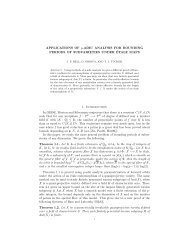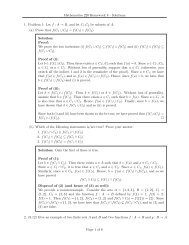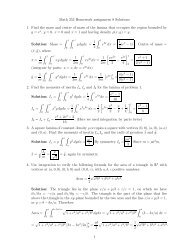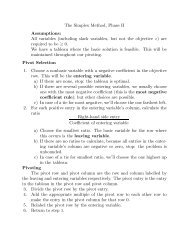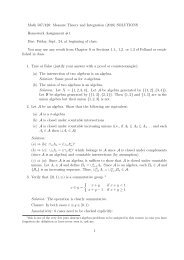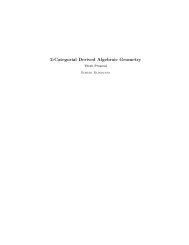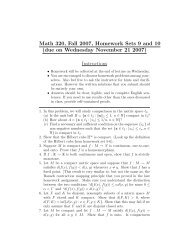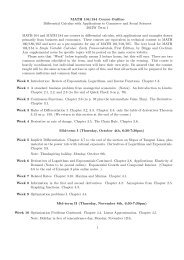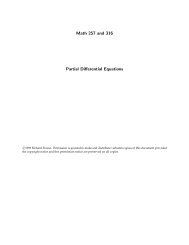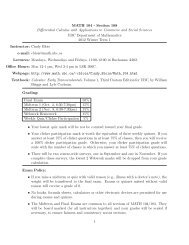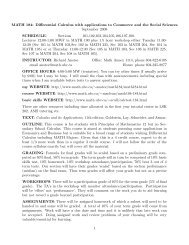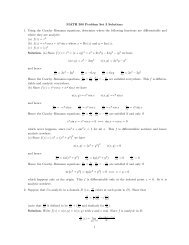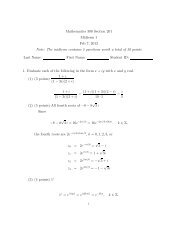The large sieve and the Bombieri–Vinogradov theorem
The large sieve and the Bombieri–Vinogradov theorem
The large sieve and the Bombieri–Vinogradov theorem
Create successful ePaper yourself
Turn your PDF publications into a flip-book with our unique Google optimized e-Paper software.
LARGE SIEVE AND BOMBIERI–VINOGRADOV THEOREM<br />
NICK HARLAND<br />
1. INTRODUCTION<br />
Let π(x; q; a) be <strong>the</strong> number of primes in an arithmetic progression up to x. More specifically, it<br />
is <strong>the</strong> cardinality of <strong>the</strong> set {p | p prime, p ≡ a (mod q), p ≤ x}. Notationally we can write this as<br />
π(x; q; a) = <br />
1,<br />
p≡a (mod q)<br />
p≤x<br />
where it’s understood that for <strong>the</strong> purposes of this paper that p will always denote a prime. A<br />
similar function is<br />
ψ(x; q; a) = <br />
Λ(n),<br />
n≤x<br />
n≡a (mod q)<br />
where<br />
<br />
k<br />
log p n = p<br />
Λ(n) =<br />
0 o<strong>the</strong>rwise.<br />
Facts about <strong>the</strong> number of primes in an arithmetic progression can often be more easily studied<br />
by looking at <strong>the</strong> function ψ(x; q; a) ra<strong>the</strong>r than π(x; q; a), <strong>and</strong> we can use Euler Summation to go<br />
from <strong>the</strong> latter to <strong>the</strong> former. <strong>The</strong> prime number <strong>the</strong>orem for arithmetic progressions asserts that<br />
for (a, q) = 1 <strong>and</strong> q ≤ log A x we have (see [6, Corollary 11.19])<br />
ψ(x; q; a) = x<br />
<br />
+ OA x log<br />
φ(q) −A <br />
x<br />
for any constant A. <strong>The</strong> error term, however is quite far from what we would expect. For example<br />
under <strong>the</strong> Generalized Riemann Hypo<strong>the</strong>sis, we get that for (a, q) = 1, (see [6, Corollary 13.8])<br />
ψ(x; q; a) = x<br />
<br />
√x 2<br />
+ O log x . (1)<br />
φ(q)<br />
<strong>The</strong> <strong>Bombieri–Vinogradov</strong> <strong>The</strong>orem is an unconditional result which says that while for any specific<br />
q, <strong>the</strong> error term might be <strong>large</strong>, on average over a certain range, <strong>the</strong> error term resembles<br />
that of (1). That is over a sum of q ≤ Q, we should get that <strong>the</strong> error is Qx 1/2 log 2 x. We will get<br />
something close to that by proving <strong>the</strong> following <strong>the</strong>orem<br />
<strong>The</strong>orem 1. [<strong>Bombieri–Vinogradov</strong>] Let A > 0 be fixed, <strong>and</strong> let E(x; q, a) = ψ(x; q; a) − x<br />
φ(q) .<br />
<strong>The</strong>n <br />
max<br />
where Q = x 1/2 log −B x, for B = 2A + 8.<br />
(a,q)=1<br />
q≤Q<br />
|E(x; q, a)| ≪A x log −A x, (2)<br />
1
Most proofs of <strong>the</strong> <strong>the</strong>orem involve <strong>the</strong> Large Sieve which we’ll start by discussing below.<br />
2. THE ADDITIVE LARGE SIEVE<br />
A <strong>sieve</strong> in number <strong>the</strong>ory is one meant to take a set S of natural numbers, <strong>and</strong> ”sift out” all <strong>the</strong><br />
numbers lying in ano<strong>the</strong>r set Ωp modulo primes p. For example <strong>the</strong> Sieve of Eratos<strong>the</strong>nes eliminates<br />
all numbers congruent to 0 modulo p except p itself. What’s left are <strong>the</strong> primes.<br />
Recall <strong>the</strong> notation<br />
e(z) = e 2πiz<br />
which will be used in <strong>the</strong> following corollary as well as throughout <strong>the</strong> rest of <strong>the</strong> paper. <strong>The</strong><br />
following is taken from [4, Chapter 7] We’ll start by proving <strong>the</strong> following, called <strong>the</strong> additive<br />
<strong>large</strong> <strong>sieve</strong>.<br />
<strong>The</strong>orem 2. Let an be complex numbers, M <strong>and</strong> N be natural numbers with n ∈ {M + 1, ..., M +<br />
N}. <strong>The</strong>n we have <strong>the</strong> following<br />
where a = <br />
|ai| 2 .<br />
i<br />
<br />
q<br />
q≤Q a=1<br />
(a,q)=1<br />
<br />
<br />
<br />
<br />
M+N <br />
n=M+1<br />
<br />
an<br />
ane<br />
q<br />
≤ (Q 2 + N − 1)a 2 , (3)<br />
<strong>The</strong> idea behind <strong>the</strong> proof is that we want to show if numbers are not too close toge<strong>the</strong>r, <strong>the</strong>n <strong>the</strong><br />
sum in (3) can’t get too <strong>large</strong>. <strong>The</strong>n we use that <strong>the</strong> rational numbers are spaced out well enough.<br />
Note that <strong>the</strong> reason we call it <strong>the</strong> ”additive” <strong>large</strong> <strong>sieve</strong> is <strong>the</strong> use of <strong>the</strong> additive characters in <strong>the</strong><br />
sum. In order to prove <strong>The</strong>orem 2 we’ll need some preliminary definitions <strong>and</strong> lemmas. Before<br />
we get into our first lemma, recall <strong>the</strong> Cauchy–Schwartz inequality which we will use repeatedly.<br />
<br />
<br />
<br />
<br />
n<br />
i=1<br />
xi ¯yi<br />
<br />
<br />
<br />
<br />
2<br />
≤<br />
n<br />
|xi| 2<br />
i=1<br />
n<br />
|yi| 2<br />
We want to start with some lemmas first. <strong>The</strong>y will be useful as we will have some double sums<br />
that we want to separate into cases where <strong>the</strong> indexes are equal to each o<strong>the</strong>r <strong>and</strong> where <strong>the</strong>y are<br />
not. <strong>The</strong> next few lemmas are going to help treat <strong>the</strong> case where <strong>the</strong> indexes are not equal. Our first<br />
lemma is due to Montgomery <strong>and</strong> Vaughan [5] <strong>and</strong> is a generalization of <strong>the</strong> Hilbert Inequality.<br />
Lemma 3. Suppose λr are a finite collection of distinct real numbers with |λr − λs| ≥ δ if r = s<br />
for 0 < δ < 1<br />
2 . <strong>The</strong>n for any complex numbers zr we have<br />
<br />
<br />
zrzs <br />
<br />
<br />
π <br />
<br />
≤ |zr|<br />
δ<br />
2 . (5)<br />
(r,s)<br />
r=s<br />
λr − λs<br />
Proof. First note that without loss of generality, we can order <strong>the</strong> λr such that λ1 < λ2 < ... <strong>and</strong><br />
so we can replace <strong>the</strong> condition |λr − λs| ≥ δ with <strong>the</strong> condition |λr − λs| ≥ δ|r − s|. We’ll begin<br />
by proving<br />
Note that<br />
<br />
<br />
<br />
<br />
r<br />
r=s<br />
zs<br />
λr − λs<br />
<br />
<br />
<br />
<br />
2<br />
2<br />
r<br />
≤ π2<br />
δ 2<br />
i=1<br />
(4)<br />
<br />
|zr| 2 . (6)<br />
r
so<br />
<br />
2 <br />
<br />
<br />
<br />
<br />
<br />
<br />
<br />
<br />
<br />
f(s) <br />
= f(s) f(t) = f(s) f(t) = <br />
f(s)f(t),<br />
s<br />
s<br />
<br />
<br />
<br />
<br />
r<br />
r=s<br />
zs<br />
t<br />
λr − λs<br />
<br />
<br />
<br />
<br />
2<br />
= <br />
(s,t)<br />
zszt<br />
s<br />
<br />
r=s,t<br />
t<br />
1<br />
(λr − λs)(λr − λt) ,<br />
noting that <strong>the</strong>re are no conjugates on <strong>the</strong> λ as <strong>the</strong>y are real, we now separate <strong>the</strong> sum into two<br />
pieces based on whe<strong>the</strong>r s = t or s = t. <strong>The</strong> first sum is<br />
while <strong>the</strong> second is<br />
<br />
(s,t)<br />
s=t<br />
zszt<br />
<br />
r=s,t<br />
1<br />
(λr − λs)(λr − λt)<br />
<br />
2 1<br />
|zs| ,<br />
(λr − λs) 2<br />
s<br />
= <br />
(s,t)<br />
s=t<br />
= <br />
(s,t)<br />
s=t<br />
r=s<br />
zszt<br />
λs − λt<br />
r=s,t<br />
zszt<br />
λs − λt<br />
<br />
<br />
1<br />
<br />
r=s<br />
λr − λs<br />
1<br />
λr − λs<br />
−<br />
− <br />
1<br />
λr − λt<br />
r=t<br />
1<br />
s<br />
<br />
λr − λt<br />
t<br />
+<br />
2<br />
λs − λt<br />
Now as we sum over all s, t we notice that <strong>the</strong> two inner sums will cancel each o<strong>the</strong>r. Hence we<br />
are left with<br />
<br />
(s,t)<br />
s=t<br />
zszt<br />
λs − λt<br />
Now by using 2|zszt| ≤ |zs| 2 + |zt| 2 , we get<br />
(s,t)<br />
s=t<br />
s<br />
<br />
t=s<br />
2<br />
λs − λt<br />
<br />
= 2zszt<br />
.<br />
(λs − λt) 2<br />
(s,t)<br />
s=t<br />
<br />
2zszt<br />
<br />
(λs − λt) 2<br />
<br />
<br />
<br />
|zs|<br />
≤ 2 + |zt| 2 <br />
2 1<br />
= 2 |zs| ,<br />
(λs − λt) 2 (λs − λt) 2<br />
where <strong>the</strong> last equality is due to <strong>the</strong> pair (i, j) occurring once as s = i, t = j <strong>and</strong> once as s = j, t =<br />
i. <strong>The</strong>refore we get<br />
<br />
<br />
<br />
<br />
r<br />
r=s<br />
zs<br />
λr − λs<br />
Since |λr − λs| ≥ δ|r − s|, we get<br />
<br />
<br />
<br />
<br />
2<br />
s<br />
t=s<br />
= <br />
2 1 <br />
2 1<br />
|zs| + 2 |zs|<br />
(λr − λs) 2 (λs − λt) 2<br />
s<br />
s<br />
r=s<br />
= 3 <br />
2 1<br />
|zs| .<br />
(λr − λs) 2<br />
r=s<br />
3<br />
s<br />
t=s<br />
<br />
.
By Cauchy–Schwartz (4) we get<br />
<br />
<br />
<br />
<br />
(r,s)<br />
r=s<br />
zrzs<br />
λr − λs<br />
<br />
<br />
<br />
<br />
2<br />
3 <br />
2 1 3<br />
|zs| ≤<br />
(λr − λs) 2 δ<br />
s r=s<br />
2<br />
<br />
2 1<br />
|zs|<br />
(r − s)<br />
s r=s<br />
2<br />
≤ 3<br />
δ2 <br />
|zs| 2<br />
∞ 1<br />
2<br />
n2 <br />
≤ <br />
<br />
<br />
2<br />
|zr| <br />
<br />
r<br />
r<br />
(r,s)<br />
r=s<br />
zs<br />
λr − λs<br />
<br />
<br />
<br />
<br />
= 6<br />
δ 2<br />
= π2<br />
δ 2<br />
2<br />
s<br />
π 2<br />
6<br />
<br />
|zs| 2<br />
s<br />
<br />
|zs| 2 .<br />
s<br />
≤ <br />
r<br />
|zr| 2<br />
2 π<br />
n=1<br />
δ2 <br />
|zs| 2<br />
<br />
=<br />
s<br />
π<br />
δ<br />
<br />
|zr| 2<br />
2 which implies our <strong>the</strong>orem. <br />
We will also need <strong>the</strong> following identity in order to help with <strong>the</strong> next lemma. <strong>The</strong> proof of it<br />
will require Liousville’s <strong>The</strong>orem in complex analysis.<br />
Lemma 4. If z is a complex number with z /∈ Z, <strong>the</strong>n<br />
∞ 1<br />
+ 2z<br />
z<br />
k=1<br />
(−1) k<br />
z2 π<br />
=<br />
− k2 sin πz .<br />
Proof. First note from <strong>the</strong> power series expansion that sin πz has simple zeros at k ∈ Z. Also note<br />
that<br />
π(z − k) π<br />
lim = lim = (−1)k<br />
z→k sin πz z→k π cos πz<br />
so π<br />
sin πz has simple poles at k ∈ Z with residue (−1)k . Hence if we let<br />
S = 1<br />
∞<br />
+ 2z<br />
z<br />
K (−1) k<br />
k − z ,<br />
(−1)<br />
k=1<br />
k<br />
z2 = lim<br />
− k2 K→∞<br />
k=−K<br />
π<br />
we get that − S is an entire function. It’s clear that as |z| → ∞ away from <strong>the</strong> integers, that<br />
sin πz<br />
S is bounded. Also<br />
sin z = eiz − e −iz<br />
2i<br />
which is bounded away from 0 as long as z is not near πk for integer k, since as |Im(z)| → ∞ ⇒<br />
|sin z| → ∞, <strong>and</strong> as |Re(z)| → ∞ for Im(z) = b = 0 we get<br />
|sin z| = lim<br />
|a|→∞<br />
e −b e ia − e b e −ia<br />
4<br />
2i<br />
.<br />
r
If this went to 0, <strong>the</strong>n |e −b e ia | → |e b e −ia | However that implies e b = e −b which is impossible for<br />
b = 0. Hence sin z is bounded away from zero making π<br />
sin πz<br />
π<br />
Liousville’s <strong>The</strong>orem in complex analysis, that means that sin πz<br />
so taking limits as z → 0 yields<br />
π 1<br />
−<br />
sin πz z<br />
= C + 2z<br />
∞<br />
k=1<br />
π 1<br />
C = lim −<br />
z→0 sin πz z<br />
πz − sin πz<br />
= lim<br />
z→0 z sin πz<br />
π − π cos πz<br />
= lim<br />
z→0 sin πz + πz cos πz<br />
π<br />
= lim<br />
z→0<br />
2 sin πz<br />
2πcosπz − z sin πz<br />
Hence C = 0 yielding our identity.<br />
− S a bounded entire function. By<br />
− S is constant. Hence<br />
(−1) k<br />
z2 ,<br />
− k2 Lemma 3 yields some corollaries. Note that our summations are involving sine functions which<br />
are part of <strong>the</strong> definition of e(z).<br />
Corollary 5. If zr are complex numbers <strong>and</strong> αr ∈ R/Z with |αr − αs| ≥ δ, for 0 < δ < 1,<br />
<strong>the</strong>n 2<br />
<br />
<br />
zrzs <br />
<br />
<br />
sin π(αr − αs) ≤ δ−1 |zr| 2 .<br />
(r,s)<br />
r=s<br />
Proof. Using Lemma 3 with <strong>the</strong> values zm,r = (−1) m zr <strong>and</strong> λm,r = m + αr for 1 ≤ m ≤ K, we<br />
get<br />
<br />
<br />
<br />
<br />
<br />
(r,m),(s,n)<br />
(r,m)=(s,n)<br />
(−1) m−n<br />
<br />
zrzs <br />
<br />
m − n + αr − αs<br />
=<br />
<br />
<br />
<br />
<br />
≤ π<br />
δ<br />
r<br />
≤ πK<br />
δ<br />
= 0.<br />
<br />
zm,rzn,s<br />
λm,r − λn,s<br />
(r,m),(s,n)<br />
(r,m)=(s,n)<br />
<br />
r<br />
|zm,r| 2<br />
<br />
|zr| 2 ,<br />
noting that <strong>the</strong> δ hasn’t changed since adding an integer or multiplying by (−1) won’t effect <strong>the</strong><br />
spacing. Now if r = s we note that <strong>the</strong> term in <strong>the</strong> sum for m = i, n = j is<br />
2<br />
i−j |zr|<br />
(−1)<br />
i − j<br />
= −(−1)j−i |zr| 2<br />
r<br />
j − i<br />
which is <strong>the</strong> negative of <strong>the</strong> term for m = j, n = i. <strong>The</strong>refore <strong>the</strong>y cancel out in <strong>the</strong> sum <strong>and</strong> hence<br />
<strong>the</strong> condition (r, m) = (s, n) can be simply replaced by r = s. <strong>The</strong>refore we have<br />
5
π<br />
δ<br />
<br />
|zr| 2 ≥ 1<br />
<br />
<br />
<br />
K <br />
r<br />
<br />
<br />
= <br />
<br />
r,s<br />
r=s<br />
<br />
r,s,m,n<br />
r=s<br />
zrzs<br />
(−1) m−n<br />
<br />
zrzs <br />
<br />
m − n + αr − αs<br />
K<br />
k=−K<br />
N(k)<br />
K<br />
(−1) k<br />
<br />
<br />
<br />
k + αr − αs<br />
where N(k) is <strong>the</strong> number of pairs (m, n) with 1 ≤ m, n ≤ K such that m − n = k. Clearly<br />
N(k) = K − |k| <strong>and</strong> so we get<br />
π<br />
δ<br />
<br />
|zr| 2 <br />
<br />
≥ <br />
<br />
r<br />
r,s<br />
r=s<br />
zrzs<br />
By letting K → ∞ <strong>and</strong> using Lemma 4 we get<br />
π<br />
δ<br />
K<br />
<br />
1 − |k|<br />
<br />
k (−1) <br />
<br />
K k + αr − αs<br />
.<br />
k=−K<br />
<br />
|zr| 2 <br />
<br />
<br />
πzrzs <br />
≥ <br />
<br />
sin π(αr − αs) <br />
r<br />
r,s<br />
r=s<br />
yielding our corollary. <br />
Now <strong>the</strong> previous corollary leads directly to<br />
Corollary 6. For any real number x, complex numbers zr <strong>and</strong> αr ∈ R/Z with |αr − αs| ≥ δ for<br />
0 < δ < 1,<br />
we have<br />
2<br />
<br />
<br />
<br />
zrzs <br />
sin 2πx(αr − αs) <br />
<br />
sin π(αr − αs) ≤ δ−1 |zr| 2 .<br />
(r,s)<br />
r=s<br />
Proof. Using Lemma 5 with z ′ r = zre(xαr) <strong>and</strong> z ′′<br />
r = zre(−xαr) <strong>and</strong> noticing that |z ′′<br />
r | = |z ′ r| =<br />
|zr| we get<br />
<br />
<br />
<br />
<br />
(r,s)<br />
r=s<br />
<br />
<br />
<br />
<br />
(r,s)<br />
r=s<br />
zrzse(xαr − xαs)<br />
sin π(αr − αs)<br />
zrzse(−xαr + xαs)<br />
sin π(αr − αs)<br />
Now using that e(z) − e(−z) = 2i sin(2πz) we get<br />
6<br />
<br />
<br />
<br />
≤ δ−1 |zr| 2 <strong>and</strong><br />
<br />
<br />
<br />
≤ δ−1 |zr| 2 .<br />
r<br />
r<br />
r
(r,s)<br />
r=s<br />
zrzs sin 2πx(αr − αs)<br />
sin π(αr − αs)<br />
<br />
<br />
<br />
=<br />
<br />
<br />
<br />
<br />
(r,s)<br />
r=s<br />
<br />
<br />
≤ <br />
<br />
(r,s)<br />
r=s<br />
zrzs<br />
<br />
−1<br />
≤ δ |zr| 2 .<br />
<br />
<br />
e(x(αr − αs)) − e(x(αr − αs)) <br />
<br />
<br />
2 sin π(αr − αs) <br />
zrzse(xαr − xαs)<br />
2 sin π(αr − αs)<br />
r<br />
<br />
<br />
<br />
+<br />
<br />
<br />
<br />
<br />
(r,s)<br />
r=s<br />
zrzse(−xαr + xαs)<br />
2 sin π(αr − αs)<br />
Now we show <strong>the</strong> Duality Lemma. It allows us to interchange <strong>the</strong> order of summation. This<br />
will allow us to sum over <strong>the</strong> residues first in our <strong>the</strong>orem as opposed to over <strong>the</strong> n which will be<br />
useful.<br />
Lemma 7. Given a function φ(m, n). Suppose for any complex numbers βn we have<br />
<br />
<br />
<br />
2<br />
<br />
<br />
βnφ(m, n) <br />
≤ ∆ β 2<br />
<strong>the</strong>n for any complex numbers αn we get<br />
<br />
<br />
<br />
<br />
<br />
<br />
αmφ(m, n) <br />
<br />
Proof. If we let βn = <br />
m αmφ(m, n), <strong>the</strong>n<br />
m<br />
<br />
<br />
<br />
<br />
αmφ(m, n) <br />
<br />
n<br />
m<br />
n<br />
2<br />
n<br />
m<br />
n<br />
m<br />
2<br />
≤ ∆α 2 .<br />
= <br />
<br />
<br />
<br />
<br />
αmφ(m, n) αm ′φ(m′ <br />
, n)<br />
= <br />
αmβnφ(m, n)<br />
n<br />
= <br />
m<br />
m<br />
αm<br />
<br />
βnφ(m, n).<br />
Now let this sum be Φ(m, n) <strong>the</strong>n using Cauchy–Schwartz (4) we get,<br />
|Φ(m, n)| 2 ≤ <br />
<br />
<br />
<br />
<br />
2<br />
|αm| <br />
βnφ(m, n) <br />
<br />
by hypo<strong>the</strong>sis (7). However note that<br />
<strong>and</strong> so we are left with<br />
m<br />
Φ(m, n) = <br />
<br />
<br />
<br />
<br />
αmφ(m, n) <br />
<br />
n<br />
m<br />
m<br />
n<br />
n<br />
7<br />
2<br />
= <br />
n<br />
m ′<br />
2<br />
≤ ∆α 2 β 2<br />
|βn| 2 = β 2<br />
<br />
<br />
<br />
<br />
<br />
(7)
as needed.<br />
Φ(m, n) ≤ ∆α 2<br />
We require one more lemma. It will use <strong>the</strong> duality lemma <strong>and</strong> <strong>the</strong> additive <strong>large</strong> <strong>sieve</strong> will be a<br />
simple corollary of it using rational numbers.<br />
Lemma 8. For any αr ∈ R/Z with |αr − αs| ≥ δ for 0 < δ < 1 <strong>and</strong> any complex numbers an<br />
2<br />
with M < n ≤ M + N, we have<br />
(a)<br />
<br />
<br />
<br />
<br />
<br />
<br />
2<br />
<br />
ane(αrn) <br />
≤ (δ −1 + N)a 2 .<br />
r<br />
M
By noting that our sum is less than <strong>the</strong> <strong>the</strong> sum in 6 with x = N<br />
2<br />
M+N <br />
N=M+1<br />
<br />
finishing <strong>the</strong> proof of (a).<br />
r<br />
<br />
<br />
zre(αrn)<br />
s=r<br />
<br />
zse(−αsn) ≤ δ −1 z 2<br />
(b) Now given <strong>the</strong> an, αr <strong>and</strong> <strong>the</strong> δ from part (a), let βm = αr+k<br />
K<br />
are separated by δ . If we let<br />
K<br />
S(α) =<br />
M+N <br />
N=M+1<br />
ane(αn)<br />
<strong>the</strong>n we get ano<strong>the</strong>r trigonometric polynomial T (α) where<br />
<br />
<br />
<br />
S(αr) <br />
<br />
<br />
<br />
r<br />
2<br />
= 1<br />
K<br />
<br />
<br />
2 <br />
<br />
T (βr,k) <br />
.<br />
k,r<br />
we get that<br />
, where 1 ≤ k ≤ K. <strong>The</strong> βr,k<br />
Since T (α) ranges over <strong>the</strong> m = nK where MK + K ≤ m ≤ (M + N)K, <strong>the</strong> number of<br />
terms in <strong>the</strong> summation is N ′ = NK − K + 1. Hence part (a) says that<br />
<br />
M+N <br />
<br />
2 <br />
<br />
ane(αrn) <br />
≤ 1<br />
K (Kδ−1 + NK − K + 1)a 2<br />
As K → ∞ we get<br />
r<br />
N=M+1<br />
<br />
<br />
<br />
<br />
<br />
finishing our lemma.<br />
r<br />
M+N <br />
N=M+1<br />
<br />
<br />
ane(αrn) <br />
<br />
= (δ −1 + N − 1 − 1/K)a 2 .<br />
2<br />
≤ (δ −1 + N − 1)a 2<br />
Note that while part (b) is required for <strong>the</strong> proof of <strong>The</strong>orem 2 <strong>and</strong> <strong>The</strong>orem 9 below, <strong>the</strong> -1<br />
won’t be necessary for <strong>the</strong> proof of <strong>The</strong>orem 1. We now have enough to prove our main <strong>the</strong>orem<br />
of this section.<br />
Proof of <strong>The</strong>orem 2. Let αr be <strong>the</strong> rational numbers a<br />
q<br />
need to figure out how spaced <strong>the</strong>y are away from each o<strong>the</strong>r. If a<br />
c<br />
<br />
<br />
<br />
a b <br />
− <br />
c d<br />
=<br />
<br />
<br />
<br />
ad − bc<br />
<br />
cd .<br />
Since ad − bc is an integer <strong>and</strong> is not zero since a<br />
c<br />
(mod 1) with 1 ≤ q ≤ Q <strong>and</strong> (a, q) = 1. We<br />
b = , <strong>the</strong>n d<br />
b = we know that |ad − bc| ≥ 1 <strong>and</strong> so<br />
d<br />
<br />
<br />
<br />
a b <br />
− <br />
1<br />
c d<br />
≥ ≥ Q−2<br />
cd<br />
since 1 ≤ c, d ≤ Q. Hence we can take δ to be Q−2 so by Lemma 8 we get our <strong>the</strong>orem.<br />
9
3. THE MULTIPLICATIVE LARGE SIEVE<br />
<br />
<br />
Throughout <strong>the</strong> remainder of <strong>the</strong> paper, we will denote a = |ai| 2<br />
1/2 . <strong>The</strong> main <strong>the</strong>orem<br />
we wish to prove in this section is:<br />
<strong>The</strong>orem 9. For natural numbers M, N, let an be complex numbers with n ∈ {M +1, ..., M +N}.<br />
<strong>The</strong>n we have <strong>the</strong> following:<br />
<br />
q≤Q<br />
q<br />
φ(q)<br />
′<br />
χ (mod q)<br />
<br />
<br />
<br />
<br />
M+N <br />
N=M+1<br />
where ′<br />
χ (mod q) indicates <strong>the</strong> sum over primitive characters χ.<br />
i<br />
<br />
<br />
anχ(n) <br />
≤ (Q2 + N − 1)a 2 , (8)<br />
Note that we have multiplicative characters χ(n) explaining <strong>the</strong> terminology. To prove this<br />
<strong>the</strong>orem, we will need some basic facts about character sums. <strong>The</strong> first is orthogonality, which are<br />
just stated. <strong>The</strong> proofs are easy <strong>and</strong> can be found in any analytic number <strong>the</strong>ory book, for example<br />
[6, Pages 108,117].<br />
Lemma 10 (Orthogonality). (a)<br />
<br />
χ(n)χ(a) =<br />
(b)<br />
(c)<br />
χ (mod q)<br />
q<br />
χ(a) =<br />
a=1<br />
where χ0 is <strong>the</strong> principal character.<br />
q<br />
e(an/q)e(−am/q) =<br />
a=1<br />
φ(q) n ≡ a (mod q)<br />
0 o<strong>the</strong>rwise.<br />
φ(q) χ = χ0<br />
0 o<strong>the</strong>rwise<br />
q m ≡ n (mod q)<br />
0 o<strong>the</strong>rwise.<br />
Definition 11. Given a character χ (mod q), <strong>the</strong> Gauss Sum is<br />
τ(χ) = <br />
<br />
a<br />
χ(a)e .<br />
q<br />
a (mod q)<br />
Notice how τ relates multiplicative characters to additive ones, which is how we’ll go from <strong>the</strong><br />
additive <strong>large</strong> <strong>sieve</strong> to <strong>the</strong> multiplicative one. We’ll need some facts about <strong>the</strong> function.<br />
Lemma 12. (a) If (n, q) = 1, <strong>the</strong>n<br />
τ(χ)χ(n) = <br />
a (mod q)<br />
<br />
an<br />
χ(a)e .<br />
q<br />
(b) If χ is primitive, <strong>the</strong>n <strong>the</strong> condition (n, q) = 1 is unnecessary.<br />
(c) If χ is primitive, <strong>the</strong>n<br />
|τ(χ| = √ q.<br />
Note that we won’t actually use part (a) for our proof, but it’s nice to know <strong>and</strong> not hard to prove.<br />
10
Proof. (a)<br />
τ(χ)χ(n) = <br />
a (mod q)<br />
<br />
a<br />
χ(a)χ(n)e .<br />
q<br />
Now since (n, q) = 1, {an (mod q) | (a, q) = 1} = {a (mod q)|(a, q) = 1}. <strong>The</strong>refore we<br />
can replace a by an in <strong>the</strong> sum. So<br />
τ(χ)χ(n) = <br />
<br />
an<br />
χ(an)χ(n)e<br />
q<br />
a (mod q)<br />
= <br />
<br />
an<br />
χ(a)χ(n)χ(n)e<br />
q<br />
a (mod q)<br />
= <br />
<br />
an<br />
χ(a)e ,<br />
q<br />
a (mod q)<br />
since χ(n)χ(n) = |χ(n)| 2 = 1 for (n, q) = 1.<br />
(b) It’s true by (a) if (n, q) = 1, so it’s sufficient to show that both sides are 0 for (n, q) = 1.<br />
<strong>The</strong> left side is 0 since χ is supported on n where (n, q) = 1. As for <strong>the</strong> right side we first<br />
claim that if χ is primitive, <strong>the</strong>n for d | q, d < q <strong>and</strong> for every integer a,<br />
q<br />
n=1<br />
n≡a (mod d)<br />
χ(n) = 0.<br />
This is true since χ primitive means <strong>the</strong>re exists m, n, m ≡ n (mod d) with χ(m) =<br />
χ(n), χ(mn) = 0 Hence <strong>the</strong>re exists c with (c, q) = 1, c ≡ 1 (mod d) such that<br />
cm = n (mod q) ⇒ χ(c)χ(m) = χ(n)<br />
⇒ χ(c) = 1.<br />
Now as k runs through <strong>the</strong> residue system (mod q/d) such that (k, q/d) = 1. <strong>The</strong>n <strong>the</strong><br />
numbers n = ac + kcd runs through all <strong>the</strong> residues (mod q) with n ≡ a (mod d). So<br />
q<br />
n=1<br />
n≡a (mod d)<br />
q/d <br />
χ(n) = χ(ac + kcd)<br />
k=1<br />
q/d <br />
= χ(c) χ(a + kd)<br />
= χ(c)<br />
k=1<br />
q<br />
n=1<br />
n≡a (mod d)<br />
χ(n).<br />
Since χ(c) = 1, our sum is equal to 0 proving <strong>the</strong> claim. Now if (n, q) = 1, <strong>the</strong>n let m<br />
d<br />
with (m, d) = 1 implying d | q, d < q, <strong>and</strong> so<br />
11<br />
= n<br />
q
a (mod q)<br />
<br />
an<br />
χ(a)e =<br />
q<br />
d<br />
e(hm/d)<br />
h=1<br />
q<br />
a=1<br />
a≡h (mod d)<br />
by <strong>the</strong> claim.<br />
(c) Since <strong>the</strong>re are φ(n) value of n (mod q) with (n, q) = 1 <strong>and</strong><br />
<br />
1 (n, q) = 1<br />
χ(n)χ(n) = |χ(n)| =<br />
,<br />
0 o<strong>the</strong>rwise.<br />
we have by part (b)<br />
φ(q)|τ(χ)| 2 q<br />
= χ(n)χ(n)τ(χ)τ(χ)<br />
n=1<br />
χ(a) = 0<br />
q <br />
<br />
an <br />
<br />
−bn<br />
= χ(a)e<br />
χ(b)e<br />
q<br />
q<br />
n=1 a (mod q)<br />
b (mod q)<br />
= <br />
q<br />
<br />
(a − b)n<br />
χ(a)χ(b) e<br />
.<br />
q<br />
a (mod q) b (mod q)<br />
By orthogonality, part (c) <strong>the</strong> last sum is 0 unless a = b in which it is q, so we get<br />
φ(q)|τ(χ)| 2 = <br />
a (mod q)<br />
n=1<br />
|χ(a)| 2 q = qφ(q) ⇒ |τ(χ)| = √ q.<br />
Note that <strong>the</strong> claim in (b) is an if <strong>and</strong> only if statement, see [6, Page 284]. We can now prove<br />
<strong>the</strong> main <strong>the</strong>orem of this section. It’s based off <strong>the</strong> proof in [4, Page 179] however <strong>the</strong>y prove<br />
something stronger which we won’t need.<br />
Proof of <strong>The</strong>orem 9. Let <strong>the</strong> an, M, N be as in <strong>the</strong> statement of <strong>the</strong> <strong>the</strong>orem. Let S(α) be <strong>the</strong><br />
trigonometric sum <br />
ane(nα) as in <strong>the</strong> proof of <strong>the</strong> additive <strong>large</strong> <strong>sieve</strong>. <strong>the</strong>n by Lemma 12 (b)<br />
we get<br />
n<br />
M+N <br />
N=M+1<br />
anχ(n) = 1<br />
τ(χ)<br />
= 1<br />
τ(χ)<br />
M+N <br />
<br />
N=M+1 a (mod q)<br />
<br />
a (mod q)<br />
χ(a)S<br />
Taking <strong>the</strong> modulus of <strong>the</strong> sum <strong>and</strong> using |τ(χ))| 2 = q yields<br />
<br />
q <br />
<br />
φ(q) <br />
M+N <br />
N=M+1<br />
<br />
<br />
anχ(n) <br />
<br />
2<br />
= 1<br />
<br />
<br />
<br />
φ(q) <br />
<br />
a (mod q)<br />
<br />
an<br />
χ(a)e<br />
q<br />
<br />
a<br />
.<br />
q<br />
χ(a)S<br />
2 a <br />
.<br />
q<br />
By summing over 1 ≤ q ≤ Q <strong>and</strong> over all primitive characters (actually we’ll achieve an upper<br />
bound by summing over all characters) we get <strong>the</strong> left side of our <strong>the</strong>orem is bounded above by<br />
12
1 <br />
φ(q)<br />
<br />
<br />
<br />
<br />
<br />
<br />
<br />
<br />
<br />
<br />
q≤Q<br />
χ(a)S<br />
a (mod q)<br />
2 a <br />
≤<br />
q<br />
1 <br />
φ(q)<br />
q≤Q χ (mod q) a (mod q)<br />
q≤Q χ (mod q) a (mod q)<br />
By orthogonality, part (a) we have <br />
χ (mod q) 1 = φ(q) so <strong>The</strong>orem 2 implies<br />
<br />
S<br />
2 <br />
≤ (Q 2 + N − 1)a 2<br />
completing our proof.<br />
a<br />
q<br />
4. A RELATED FUNCTION<br />
<br />
<br />
<br />
1<br />
<br />
<br />
S<br />
2 a <br />
.<br />
q<br />
For <strong>the</strong> <strong>Bombieri–Vinogradov</strong> <strong>The</strong>orem, we are trying to show that <strong>the</strong> difference between a<br />
function over a specific arithmetic progression <strong>and</strong> <strong>the</strong> average over all arithmetic progression is<br />
relatively small. We will give a specific function for this difference, <strong>and</strong> derive some properties.<br />
Definition 13. Given an arithmetic function f, we let<br />
Df(x; q, a) = <br />
f(n) − 1<br />
φ(q)<br />
Also recall <strong>the</strong> following definition:<br />
n≤x<br />
n≡a (mod q)<br />
<br />
n≤x<br />
(n,q)=1<br />
f(n).<br />
Definition 14 (Dirichlet Convolution). Given arithmetic functions f, g, <strong>the</strong> Dirichlet Convolution<br />
is<br />
(f ∗ g)(n) = <br />
f(d)g(n/d). (9)<br />
d|n<br />
Now we will state our main <strong>the</strong>orem which will be helpful in showing <strong>the</strong> <strong>Bombieri–Vinogradov</strong><br />
<strong>The</strong>orem. It turns out <strong>the</strong> Dirichlet convolution gives an estimate which doesn’t require <strong>the</strong> difference<br />
between two sums. This will be nicer to estimate, provided we can write our function as a<br />
convolution.<br />
<strong>The</strong>orem 15. Suppose we have sequences α = (αn), β = (βn) which are supported on {1, ..., M}<br />
<strong>and</strong> {1, ..., N} respectively. Suppose<br />
Let γ = α ∗ β be <strong>the</strong> Dirichlet convolution, <strong>the</strong>n<br />
<br />
|Dβ(N; q, a)| ≤ βN 1<br />
2 ∆ 9 for some ∆ ∈ (0, 1]. (10)<br />
max<br />
(a,q)=1<br />
q≤Q<br />
|Dγ(MN; q, a)| ≪ α β(∆M 1/2 N 1/2 + M 1/2 + N 1/2 + Q) log 2 Q.<br />
To prove this, we are going to need to make <strong>the</strong> summation condition n ≡ a (mod q) easier to<br />
work with. We can use characters to do that, hence why we require <strong>the</strong> multiplicative <strong>large</strong> <strong>sieve</strong>.<br />
In <strong>the</strong> process of proving this, we will be splitting <strong>the</strong> interval 1, ..., Q into parts, so we’ll need a<br />
lemma to help deal with <strong>the</strong> small values of q. First let’s recall <strong>the</strong> formula for Möbius inversion of<br />
which <strong>the</strong> proof can be seen in any elementary number <strong>the</strong>ory textbook, for example [6, Page 35].<br />
13
Lemma 16 (Möbius Inversion). If f, <strong>and</strong> F are two arithmetic functions such that<br />
F (n) = <br />
f(d)<br />
<strong>the</strong>n<br />
where µ is <strong>the</strong> Möbius µ-function.<br />
d|n<br />
f(n) = <br />
µ(d)F (n/d)<br />
d|n<br />
Recall <strong>the</strong> elementary identity of whose proof can be found by using Möbius inversion with<br />
F (d) = 1 for all d.<br />
<br />
<br />
1<br />
µ(d) =<br />
0<br />
n = 1<br />
n > 1<br />
(11)<br />
d|n<br />
We are going to need a technical lemma first.<br />
Lemma 17. Let β = (βn) be supported on {1, ..., N}, <strong>the</strong>n for all natural numbers K, s we get<br />
<br />
µ(d) <br />
βnχ(n) = <br />
µ(d) <br />
µ(l) <br />
βnχ(n).<br />
d|s<br />
d≤K<br />
n≡0 (mod d)<br />
d|s<br />
d≤K<br />
Proof. By linearity of <strong>the</strong> finite sum, it suffices to show it’s true for<br />
<br />
1 n = n0<br />
β(n) =<br />
0 o<strong>the</strong>rwise .<br />
For this β(n), <strong>the</strong> left h<strong>and</strong> side is<br />
d|s<br />
d≤K<br />
l|d<br />
<br />
d|s<br />
d≤K<br />
l|d<br />
<br />
1 (n0, q) = 1, d | n0<br />
µ(d)<br />
0 o<strong>the</strong>rwise ,<br />
<strong>and</strong> <strong>the</strong> right h<strong>and</strong> side is<br />
<br />
µ(d) <br />
<br />
1 (n0, q) = 1, (n0, l) = 1<br />
µ(l)<br />
0 o<strong>the</strong>rwise<br />
= <br />
(n,l)=1<br />
d|s<br />
d≤K<br />
(n0,q)=1<br />
Since µ(d) is only supported on square free numbers <strong>the</strong> inner sum is<br />
hence by (11) we get that this is<br />
⎧<br />
⎪⎨<br />
⎪⎩<br />
<br />
l| <br />
p<br />
p|d<br />
(n,p)=1<br />
1 <br />
p|d<br />
(n,p)=1<br />
µ(l),<br />
p = 1<br />
0 o<strong>the</strong>rwise<br />
14<br />
,<br />
µ(d) <br />
l|d<br />
(n0,l)=1<br />
µ(l).
in o<strong>the</strong>r words d | n0. Hence <strong>the</strong> right h<strong>and</strong> side is<br />
<br />
<br />
1 d | n0<br />
µ(d)<br />
0 o<strong>the</strong>rwise<br />
d|s<br />
d≤K<br />
(n0,q)=1<br />
finishing our lemma. <br />
Now we will show a lemma that can help us deal with <strong>the</strong> resulting sum that will arise when<br />
changing <strong>the</strong> summation condition to sums involving characters.<br />
Lemma 18. If β = (βn) is a sequence supported on {1, ..., N} satisfying <strong>the</strong> conditions in equation<br />
(10) <strong>the</strong>n for all χ, a non-principal character (mod r) <strong>and</strong> positive integers s we have<br />
<br />
<br />
<br />
<br />
βnχ(n) <br />
≤ β|N 1/2 ∆ 3 rτ(s),<br />
(n,s)=1<br />
where τ(s) is <strong>the</strong> number of positive divisors of s.<br />
Proof. Using (11) we get <br />
(n,s)=1<br />
βnχ(n) = <br />
βnχ(n) <br />
µ(d)<br />
n<br />
d|(n,s)<br />
= <br />
µ(d) <br />
d|s<br />
n≡0 (mod d)<br />
βnχ(n).<br />
We are going to split <strong>the</strong> sum over d at <strong>the</strong> value K. For d ≤ K we have<br />
<br />
µ(d) <br />
βnχ(n) = <br />
µ(d) <br />
µ(l) <br />
βnχ(n)<br />
d|s<br />
d≤K<br />
n≡0 (mod d)<br />
d|s<br />
d≤K<br />
l|d<br />
(n,l)=1<br />
by Lemma 17. Looking at <strong>the</strong> inner sum over residue classes (mod lr) <strong>and</strong> looking at <strong>the</strong> condition<br />
given in (10) we know that<br />
<br />
(n,l)=1<br />
βnχ(n) =<br />
<strong>The</strong> leading term goes to 0 since<br />
=<br />
=<br />
lr<br />
<br />
a=1 n≡a (mod lr)<br />
(a,lr)=1<br />
lr<br />
a=1<br />
(a,lr)=1<br />
lr<br />
a=1<br />
(a,lr)=1<br />
χ(a) <br />
βnχ(n)<br />
n≡a (mod lr)<br />
<br />
<br />
χ(a)<br />
lr<br />
a=1<br />
(a,lr)=1<br />
(n,lr)=1<br />
χ(a) = 0,<br />
15<br />
βn<br />
βn + O( βN 1<br />
2 ∆ 9 <br />
) .
giving us<br />
<strong>The</strong>refore our sum over d ≤ K is<br />
using that<br />
≪ βN 1<br />
2 ∆<br />
<br />
(n,l)=1<br />
βnχ(n) ≪ φ(lr) βN 1<br />
2 ∆ 9 .<br />
<br />
9<br />
|µ(d)| <br />
|µ(l)|φ(lr) ≤ βN 1<br />
2 ∆ 9 Kφ(r)τ(s),<br />
d|s<br />
d≤K<br />
As for <strong>the</strong> part where d > K, we have<br />
<br />
l|d<br />
<br />
φ(l) = d ≤ K <strong>and</strong> <br />
1 ≤ τ(s).<br />
l|d<br />
d|s<br />
d>K<br />
µ(d) <br />
n≡0 (mod d)<br />
d|s<br />
d≤K<br />
βnχ(n).<br />
Using Cauchy–Schwartz (4) on <strong>the</strong> inside summation, we get<br />
<br />
<br />
<br />
<br />
<br />
n≡0 (mod d)<br />
<br />
<br />
βnχ(n) <br />
<br />
Hence our sum for d > K yields<br />
<br />
1/2<br />
βN<br />
d|s<br />
d>K<br />
2<br />
≤ <br />
n≡0 (mod d)<br />
≤ 2 N<br />
β<br />
d .<br />
|βn| 2<br />
<br />
n≡0 (mod d)<br />
d −1/2 ≤ βN 1/2 K −1/2 τ(s),<br />
|χn| 2<br />
since <strong>the</strong>re are at most τ(s) such d, all of which have d −1/2 < K −1/2 By letting K = ∆ −6 we get<br />
<br />
<br />
<br />
<br />
<br />
(n,s)=1<br />
<br />
<br />
βnχ(n) <br />
≤ βN 1/2 ∆ 3 φ(r)τ(s) + βN 1/2 ∆ 3 τ(s)<br />
≤ βN 1/2 ∆ 3 rτ(s).<br />
In <strong>the</strong> proof of our <strong>the</strong>orem, we wish to underst<strong>and</strong> <strong>the</strong> function Dγ(MN; q, a), so in our next<br />
lemma will express it as a product of sums instead of a difference which will be much easier to<br />
work with.<br />
Lemma 19.<br />
Dγ(MN; q, a) = 1<br />
φ(q)<br />
<br />
χ (mod q)<br />
χ=χ0<br />
where χ0 is <strong>the</strong> principal character (mod q).<br />
<br />
<br />
χ(a)<br />
16<br />
m≤M<br />
<br />
<br />
αmχ(m)<br />
n≤N<br />
<br />
βnχ(n)
Proof. We will prove this by exp<strong>and</strong>ing out <strong>the</strong> definition of Dγ(MN; q, a) <strong>and</strong> noticing some<br />
cancellation in <strong>the</strong> resulting sums.<br />
Dγ(MN; q, a) = <br />
k≤MN<br />
k≡a (mod q)<br />
γ(k) − 1<br />
φ(q)<br />
<br />
k≤MN<br />
(k,q)=1<br />
γ(k).<br />
By orthogonality part (a) we can replace <strong>the</strong> condition k ≡ a (mod q) with <strong>the</strong> sum<br />
1<br />
φ(q)<br />
<br />
χ(k)χ(a),<br />
to get<br />
1<br />
φ(q)<br />
<br />
<br />
k≤MN χ (mod q)<br />
(k,q)=1<br />
Note that for <strong>the</strong> principal character,<br />
<br />
k≤MN<br />
(k,q)=1<br />
χ (mod q)<br />
χ(k)χ(a)γ(k) − 1<br />
φ(q)<br />
χ0(k)γ(k) = <br />
since χ0(k) = 1 for all (k, q) = 1. We are left with<br />
1<br />
φ(q)<br />
We’re left to show<br />
<br />
<br />
k≤MN χ=χ0 (mod q)<br />
(k,q)=1<br />
<br />
k≤MN<br />
(k,q)=1<br />
To this end we get<br />
<br />
m≤M<br />
χ(a)χ(k)γ(k) = 1<br />
φ(q)<br />
<br />
<br />
χ(k)γ(k) =<br />
<br />
<br />
αmχ(m)<br />
n≤N<br />
m≤M<br />
k≤MN<br />
(k,q)=1<br />
γ(k),<br />
<br />
χ=χ0 (mod q)<br />
<br />
<br />
αmχ(m)<br />
<br />
βnχ(n) = <br />
n≤N<br />
m≤M n≤N<br />
<br />
k≤MN<br />
(k,q)=1<br />
γ(k).<br />
χ(a) <br />
k≤MN<br />
(k,q)=1<br />
<br />
βnχ(n) .<br />
<br />
αmβnχ(mn).<br />
χ(k)γ(k).<br />
Letting k = mn <strong>the</strong> coefficient of χ(k) is <strong>the</strong> sum of all αmβn with mn = k.However since<br />
γ = α ∗ β, we get that <strong>the</strong> coefficient is<br />
<br />
α(m)β(k/m) = γ(k)<br />
finishing <strong>the</strong> lemma.<br />
m|k<br />
Due to two sums which will come up in <strong>the</strong> proof we will establish <strong>the</strong> following estimates,<br />
whose proofs rely on properties of multiplicative functions.<br />
17
Lemma 20. (a)<br />
(b)<br />
<br />
s≤Q<br />
<br />
s≤Q<br />
τ(s)<br />
φ(s) ≤ log2 Q. (12)<br />
1<br />
φ(s)<br />
≤ log Q. (13)<br />
Proof. For any non-negative multiplicative function f(n) we first claim that<br />
<br />
f(n) ≤ ∞<br />
f(p k ),<br />
since by letting<br />
n≤x<br />
p≤x k=0<br />
n = p ap<br />
be <strong>the</strong> prime factorization of n, <strong>the</strong>n since p ≤ n, all p have p ≤ x <strong>and</strong> all products of those p ap<br />
occur on <strong>the</strong> right h<strong>and</strong> side of <strong>the</strong> inequality. Using<br />
f(n) = f(p ap )<br />
finishes <strong>the</strong> claim.<br />
(a) Now τ(s) <strong>and</strong> φ(s) are both non-negative multiplicative functions <strong>and</strong> φ(s) is never zero,<br />
hence <strong>the</strong>ir quotient is clearly non-negative <strong>and</strong> multiplicative <strong>and</strong> so <strong>the</strong> claim applies to<br />
give us<br />
<br />
τ(s)<br />
φ(s)<br />
τ(p<br />
s≤Q<br />
p≤Q k=0<br />
k )<br />
φ(pk ) .<br />
Using that τ(pk ) = k + 1 <strong>and</strong> φ(pk ) = pk−1 (p − 1) we get<br />
k=1<br />
<br />
s≤Q<br />
τ(s)<br />
φ(s)<br />
≤ <br />
p≤Q<br />
≤ <br />
<br />
1 +<br />
∞<br />
∞<br />
k=1<br />
k + 1<br />
p k−1 (p − 1)<br />
<strong>The</strong> sum is absolutely convergent for any p so we are permitted to rearrange <strong>the</strong> sum to get<br />
∞ k + 1<br />
1 +<br />
pk−1 (p − 1) =<br />
∞ 1<br />
1 +<br />
pk−1 ∞ ∞ 1<br />
+<br />
(p − 1)<br />
pk−1 (p − 1)<br />
k=1<br />
since each k term will occur once in <strong>the</strong> first sum <strong>and</strong> k times in <strong>the</strong> double sum, once for<br />
each 1 ≤ l ≤ k. Now using geometric series this is equal to<br />
1 + 1 1<br />
p − 1 1 − 1<br />
∞ 1<br />
+<br />
p p l=1<br />
l−1 1<br />
(p − 1) 1 − 1<br />
p<br />
p 1<br />
= 1 + +<br />
(p − 1) 2 (p − 1) 2<br />
∞<br />
p 2−l .<br />
which is ano<strong>the</strong>r geometric series yielding<br />
1 +<br />
p<br />
+<br />
(p − 1) 2<br />
l=1<br />
<br />
.<br />
k=l<br />
l=1<br />
p2 (p − 1) 3 = 1 + 2p2 − p<br />
.<br />
(p − 1) 3<br />
18
<strong>The</strong> product of <strong>the</strong>se factors can be written as <strong>the</strong> exponential of a sum of <strong>the</strong>ir logarithms<br />
to get<br />
<br />
<br />
<br />
exp log 1 + 2p2 − p<br />
(p − 1) 3<br />
<br />
.<br />
p≤Q<br />
Using that log(1 + x) ≤ x we get that<br />
<br />
log 1 + 2p2 − p<br />
(p − 1) 3<br />
<br />
≤ 2p2 <br />
− p 2<br />
1<br />
= + O<br />
(p − 1) 3 p − 1 (p − 1) 2<br />
<br />
= 2<br />
<br />
1<br />
+ O<br />
p p2 <br />
.<br />
Since <strong>the</strong> sum <br />
n≥1 n−2 converges, so does <strong>the</strong> sum over primes, <strong>and</strong> using Merten’s [6,<br />
<strong>The</strong>orem 2.7] we get<br />
<br />
s≤Q<br />
concluding <strong>the</strong> lemma.<br />
(b) Similar to part (a) we can get that<br />
<br />
s≤Q<br />
1<br />
φ(s)<br />
τ(s)<br />
φ(s) ≤ e2 log log Q+C ≪ log 2 Q<br />
≤ <br />
∞ 1<br />
φ(pk )<br />
∞<br />
1 +<br />
p≤Q k=0<br />
= <br />
p≤Q<br />
= <br />
p≤Q<br />
<br />
1 +<br />
p≤Q<br />
k=1<br />
1<br />
pk−1 <br />
(p − 1)<br />
<br />
.<br />
p<br />
(p − 1) 2<br />
Once again converting to sums of logarithms we get<br />
<br />
<br />
1 <br />
<br />
p<br />
≤ exp log 1 +<br />
φ(s) (p − 1)<br />
s≤Q<br />
p≤Q<br />
2<br />
<br />
<br />
p<br />
≤ exp<br />
(p − 1)<br />
p≤Q<br />
2<br />
<br />
<br />
<br />
<br />
1 1<br />
= exp + O<br />
p (p − 1) 2<br />
<br />
≪ log Q<br />
We now have enough to prove <strong>the</strong> main <strong>the</strong>orem of this section. <strong>The</strong> idea is to take our product<br />
form of <strong>the</strong> sum established in Lemma 19 <strong>and</strong> <strong>the</strong>n some <strong>the</strong>m over primitive characters so we<br />
can use some of our previous lemmas. We will also be splitting <strong>the</strong> interval from 1 to Q into<br />
small values, as well as dyadic intervals to help deal with <strong>large</strong>r values where we will use <strong>the</strong><br />
multiplicative <strong>large</strong> <strong>sieve</strong>.<br />
19<br />
p≤Q
Proof of <strong>The</strong>orem 15. By Lemma 19 we have<br />
Dγ(MN; q, a) = 1 <br />
<br />
<br />
χ(a)<br />
φ(q)<br />
χ (mod q)<br />
χ=χ0<br />
m<br />
<br />
<br />
αmχ(m)<br />
n<br />
<br />
βnχ(n) .<br />
Now we wish to reduce <strong>the</strong> characters (mod q) to primitive characters. Suppose <strong>the</strong> character χ<br />
is induced by a primitive character (mod r). <strong>The</strong>n r | q so let s be such that q = rs. <strong>The</strong>n since<br />
φ(q) ≥ φ(r)φ(s) we get that<br />
<br />
max<br />
(a,q)=1 |Dγ(MN; q, a)| ≤ <br />
<br />
<br />
max <br />
1<br />
φ(q)<br />
q≤Q<br />
(a,q)=1<br />
q≤Q<br />
≤ <br />
s≤Q<br />
1<br />
φ(s)<br />
<br />
1
so by <strong>the</strong>orem 9 we get<br />
<br />
P y<br />
k>z<br />
km|n<br />
called an incomplete logarithm. Note that 0 ≤ λ(l) ≤ log l, since <strong>the</strong> sum just subtracts log p<br />
(with multiplicity) for some of <strong>the</strong> primes dividing l. Also note that if l ≤ x 1/5 , <strong>the</strong>n λ(l) = 0. We<br />
establish <strong>the</strong> following lemma to split up Λ(n) into more tangible pieces.<br />
Lemma 21. If x 1/5 < n ≤ x,<br />
Λ(n) = <br />
m≤x 1/5<br />
lm=n<br />
λ(l)µ(m) +<br />
21<br />
<br />
x 1/5
Proof. We will show this by inserting <strong>the</strong> definition of λ(l) <strong>and</strong> rearranging.<br />
<br />
λ(l)µ(m) +<br />
<br />
λ(l)µ(m)<br />
= <br />
m≤x 1/5<br />
m|n<br />
= <br />
m≤x 1/5<br />
lm=n<br />
µ(m) log<br />
m≤x 1/5<br />
lm=n<br />
<br />
log l − <br />
k≤x 1/5<br />
k|l<br />
<br />
m<br />
−<br />
n<br />
<br />
m≤x 1/5<br />
lm=n<br />
<br />
Λ(k) µ(m) +<br />
<br />
k≤x 1/5<br />
k|l<br />
x 1/5
If we let Λ ′ (n), Λ ′′ (n) be <strong>the</strong> two sums above for x 1/5 < n ≤ x, <strong>the</strong>n note that by trivial estimates<br />
<strong>and</strong> so<br />
<br />
n≤x 1/5<br />
n≡a (mod q)<br />
Λ(n) − 1<br />
φ(q)<br />
<br />
n≤x 1/5<br />
(n,q)=1<br />
Λ(n) ≪ <br />
n≤x 1/5<br />
log(n) ≤ x 1/5 log x<br />
DΛ(x; q, a) = DΛ ′(x; q, a) + DΛ ′′(x; q, a) + O(x1/5 log x).<br />
For DΛ ′(x; q, a) we have <strong>the</strong> following lemma.<br />
Lemma 22.<br />
Proof. We start by showing<br />
<strong>The</strong> left h<strong>and</strong> side is<br />
<br />
n≤x<br />
n≡a (mod q)<br />
log n − 1<br />
φ(q)<br />
<br />
Dλ(x; q, a) = <br />
<br />
n≤x<br />
(n,q)=1<br />
max<br />
(a,q)=1<br />
q≤Q<br />
|DΛ ′(x; q, a)| ≪ Qx2/5 .<br />
n≤x<br />
n≡a (mod q)<br />
λ(l) − 1<br />
φ(q)<br />
<br />
<br />
log n −<br />
<br />
n≤x<br />
(n,q)=1<br />
<br />
n≤x k≤x<br />
n≡a (mod q)<br />
1/5<br />
k|n<br />
λ(l) ≪ x 1/5 . (15)<br />
Λ(k) − 1<br />
φ(q)<br />
Since log n increases <strong>and</strong> is positive, <strong>the</strong> first bracket is bounded above by<br />
n≤x k≤x<br />
n≡a (mod q)<br />
1/5<br />
k|n<br />
log x − log Kq +<br />
K<br />
k=1<br />
n≤x k≤x<br />
(n,q)=1<br />
1/5<br />
k|n<br />
<br />
<br />
log kq − 1<br />
<br />
(φ(q)) log(k − 1)q<br />
φ(q)<br />
k≤x 1/5<br />
n≤x<br />
n≡a (mod q)<br />
n≡0 (mod k)<br />
<br />
n≤x k≤x<br />
(n,q)=1<br />
1/5<br />
k|n<br />
<br />
Λ(k) .<br />
which telescopes to give us log x. As for <strong>the</strong> second bracket, by switching <strong>the</strong> order of summation<br />
we can get<br />
<br />
Λ(k) − 1 <br />
Λ(k) =<br />
φ(q)<br />
<br />
<br />
<br />
Λ(k) 1 − 1 <br />
<br />
1<br />
φ(q)<br />
n≤x<br />
(n,q)=1<br />
n≡0 (mod k)<br />
Inside <strong>the</strong> bracket, over any residue system rkq < n ≤ (r + 1)kq <strong>the</strong> sums will cancel each o<strong>the</strong>r<br />
leaving us with a summation over a range of at most kq values, of which <strong>the</strong> first sum counts at<br />
most one of <strong>the</strong>m as does <strong>the</strong> last. At worst we get <strong>the</strong> inner bracket being ≪ 1 Hence we get<br />
<br />
k≤x 1/5<br />
Λ(k) = ψ(x 1/5 ) ≪ x 1/5<br />
by <strong>the</strong> prime number <strong>the</strong>orem. Returning to our main summation, by rearranging <strong>the</strong> variables by<br />
using <strong>the</strong> condition that lm = n, we can get<br />
23
max |DΛ ′(x; q, a)| =<br />
(a,q)=1<br />
q≤Q<br />
using (15).<br />
q≤Q<br />
= <br />
q≤Q<br />
≤ <br />
max<br />
a<br />
max<br />
a<br />
<br />
<br />
<br />
<br />
<br />
<br />
n≤x m≤x<br />
n≡a (mod q)<br />
1/5<br />
m|n<br />
lm=n<br />
<br />
<br />
<br />
<br />
q≤Q m≤x1/5 (m,q)=1<br />
≤ <br />
<br />
<br />
q≤Q m≤x1/5 (m,q)=1<br />
<br />
m≤x 1/5<br />
(m,q)=1<br />
µ(m)<br />
|µ(m)| max<br />
a<br />
λ(l)µ(m) − 1<br />
φ(q)<br />
<br />
l≤x/m<br />
l≡am−1 (mod q)<br />
<br />
<br />
<br />
<br />
<br />
l≤x/m<br />
l≡am −1 (mod q)<br />
|µ(m)|x 1/5 ≪ Qx 2/5<br />
<br />
λ(l) − 1<br />
φ(q)<br />
λ(l) − 1<br />
φ(q)<br />
<br />
n≤x m≤x<br />
(n,q)=1<br />
1/5<br />
m|n<br />
lm=n<br />
<br />
m≤x 1/5<br />
(m,q)=1<br />
<br />
l≤x/m<br />
(l,q)=1<br />
<br />
<br />
λ(l)µ(m) <br />
<br />
µ(m) <br />
<br />
<br />
λ(l) <br />
<br />
l≤x/m<br />
(l,q)=1<br />
It remains to look at DΛ ′′(x; q, a). We chop up our interval from 1 to x into intervals y ≤ n ≤<br />
(1 + δ)y where x−1/5 < δ ≤ 1. <strong>The</strong>re are O(δ−1 log x) such intervals since if <strong>the</strong>re are J intervals,<br />
<strong>the</strong>n<br />
(1 + δ) ⌊J⌋ = x 3/5<br />
⇒ J ≪<br />
We will now change <strong>the</strong> summation condition<br />
to <strong>the</strong> condition<br />
log x<br />
log(1 + δ) ≪ δ−1 log x.<br />
lm = n, x 1/5 < m ≤ x 4/5<br />
lm = n, L < l < (1 + δ)L, M < m < (1 + δ)M<br />
where L, M are of <strong>the</strong> form (1 + δ) j , x 1/5 < L, M < x 4/5 <strong>and</strong> LM < x. Note that this won’t<br />
cover all possible values of n. For example it won’t cover n < x 1/5 however that wasn’t part of <strong>the</strong><br />
original condition anyways, <strong>and</strong> it won’t properly cover (i.e. it won’t cover with multiplicity one)<br />
(1 + δ) −1 x < n < (1 + δ)x<br />
Separately taking this piece leads us to <strong>the</strong> following lemma.<br />
Lemma 23.<br />
<br />
(1+δ) −1 x
Proof. By rearranging <strong>the</strong> conditions on <strong>the</strong> summation in a similar way to how we did it when<br />
showing (15) we get<br />
<br />
=<br />
<br />
x 1/5
using that <br />
<br />
max<br />
(a,q)=1<br />
q≤Q<br />
|DΛ ′′(x; q, a)| ≪ δ−1∆x log 5 x + δx log 3 x<br />
q<br />
q≤Q<br />
−1 ≪ log Q ≤ log x. Set δ = ∆1/2 log 2 x, which at most 1 for B ≥ 4. <strong>The</strong> bound<br />
<strong>the</strong>n becomes ∆1/2x log 4 x.<br />
<strong>The</strong>refore we conclude that<br />
<br />
<br />
<br />
max <br />
1<br />
(a,q)=1 ψ(x; q, a) −<br />
φ(q)<br />
q≤Q<br />
<br />
n≤x<br />
(n,q)=1<br />
<br />
<br />
Λ(n) <br />
= max<br />
(a,q)=1 |DΛ(x; q, a)|<br />
q≤Q<br />
≪ ∆ 1/2 x log 4 x.<br />
However with <strong>the</strong> exception of <strong>the</strong> finite number of primes dividing q with are not counted in<br />
<strong>the</strong> sum, we have<br />
<br />
Λ(n) = ψ(x) = x + O(x log −C x)<br />
n≤x<br />
(n,q)=1<br />
for any constant C by <strong>the</strong> prime number <strong>the</strong>orem. Hence we have<br />
<br />
<br />
<br />
max <br />
x <br />
(a,q)=1 ψ(x; q, a) − <br />
φ(q) ≪A x(log x)<br />
q≤Q<br />
which gives us <strong>Bombieri–Vinogradov</strong> for B(A) = 2A + 8.<br />
B<br />
− 2 +4<br />
We have been following <strong>the</strong> proof in [4, Chapter 17] however our result is slightly different.<br />
<strong>The</strong>y got B = 2A + 6 however <strong>the</strong>y appear to have an error. <strong>The</strong>y say that <strong>the</strong>re are O(δ −1 )<br />
intervals dividing x 1/5 < n ≤ x 4/5 which is clearly false when δ is constant <strong>and</strong> appears to be false<br />
in general. Hence our O(δ −1 log x) gives us an extra logarithm in our <strong>the</strong>orem.<br />
6. NOTES, ADDITIONAL RESULTS AND REFERENCES<br />
In Bombieri’s original paper [1], he showed <strong>the</strong> constant B = 3A + 23. Note that it’s possible<br />
to do better for <strong>the</strong> value of B than we did. <strong>The</strong> following has been shown in [2, Chapter 28].<br />
<br />
max<br />
(a,q)=1 max<br />
y≤x |E(y; q, a)| ≪ x1/2Q log 5 x (17)<br />
q≤Q<br />
where x 1/2 log −A x ≤ Q ≤ x 1/2 . which is even stronger with B = A + 5.<br />
Even under GRH we don’t get what’s considered to be <strong>the</strong> correct error term for ψ(x; q, a). It’s<br />
conjectured [6, Conjecture 13.9] that<br />
which since <br />
E(x; q, a) ≪ɛ x 1/2+ɛ /q 1/2<br />
q −1/2 ≪ x 1/2−ɛ/2<br />
q≤x1−ɛ would imply <strong>the</strong> conjecture by Elliott–Halberstam that we can increase <strong>the</strong> range of values of Q<br />
all <strong>the</strong> way to x1−ɛ .<br />
26
It might be thought that we can even do better than <strong>the</strong> Elliott–Halberstam conjecture, perhaps<br />
even having q up to x itself. However a result of Friedl<strong>and</strong>er <strong>and</strong> Granville [3] showed <strong>the</strong> following.<br />
<strong>The</strong>orem 24. For any N > 0, <strong>the</strong>re exists arbitrarily <strong>large</strong> value of a <strong>and</strong> x for which<br />
<br />
<br />
<br />
<br />
x <br />
ψ(x; q, a) − <br />
φ(q) ≫N x.<br />
q 0 be fixed, <strong>and</strong> let E(x; q, a) = π(x; q; a) − li(x)<br />
, <strong>the</strong>n<br />
φ(q)<br />
<br />
max<br />
where Q = x 1/2 log −B x, for B depending on A.<br />
(a,q)=1<br />
q≤Q<br />
|E(x; q, a)| ≪A x log −A x, (18)<br />
By mimicking <strong>the</strong> proof of <strong>Bombieri–Vinogradov</strong> we can prove a similar type result called <strong>the</strong><br />
Barban–Davenport–Halberstam <strong>The</strong>orem with <strong>the</strong> proof shown in [4, Page 424].<br />
<strong>The</strong>orem 26.<br />
<br />
q≤Q<br />
<br />
a (mod q)<br />
(a,q)=1<br />
<br />
ψ(x; q, a) − x<br />
2 ≪A x log<br />
φ(q)<br />
−A x,<br />
for <strong>and</strong> A > 0 where Q = x 1/2 log −B x with B depending on A.<br />
REFERENCES<br />
[1] E. Bombieri, ”On <strong>the</strong> <strong>large</strong> <strong>sieve</strong>”. Ma<strong>the</strong>matica 12 (1965), 201-225.<br />
[2] H. Davenport, Multiplicative Number <strong>The</strong>ory Third Edition, Graduate Texts in Math., New York: Springer-<br />
Verlag, Vol. 74 (2000).<br />
[3] J. Friedl<strong>and</strong>er <strong>and</strong> A. Granville, ”Limitations to <strong>the</strong> equi-distribution of primes I”. <strong>The</strong> Annals of Math., 129<br />
(1989), 362-382.<br />
[4] H.Iwaniec <strong>and</strong> E Kowalski, Analytic Number <strong>The</strong>ory, Colloquim Publications (American Ma<strong>the</strong>matical Society)<br />
Vol. 53 (2004).<br />
[5] H. L. Montgomery <strong>and</strong> R. C. Vaughan, ”Hilbert’s inequality”. J. London Math. Soc. (2) 8 (1974), 73–82.<br />
[6] H. L. Montgomery <strong>and</strong> R. C. Vaughan, Multiplicative Number <strong>The</strong>ory I: Classical <strong>The</strong>ory, Cambridge University<br />
Press (2007).<br />
[7] R. C. Vaughan, ”Sommes trigonometriques sur les numbres premiers”. C. R. Acad. Sci Paris Ser. A-B 285<br />
(1977), A981–A983.<br />
27



